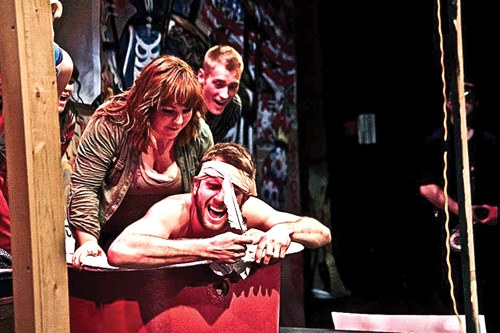Thanks to Aleksander Lukac’s globally-acclaimed production Move.(me).ant that allows the audience to tweet while watching, you’ll never have to hush again
Jessica Gilligan
Contributor

Social networking has exploded in the last few years, allowing for better communication with people all over the world. The impacts that networks such as Twitter, YouTube, and Facebook have on our society are countless, and we can’t deny it.
Professor Aleksandar (Sasha) Lukac, Course Director at Glendon’s drama studies program and self-described as “Theatre Director and Human Being (in that order)” on his Twitter page, recognizes the impact of social networking on our lives, on politics, and on art. As a professor of political theatre, Lukac embraces creative ways to raise awareness in word issues. With his most recent production Move.(me).ant: The Marat/Sade Occupied, Lukac took raising awareness to the next level.
Adapted from Peter Weiss’s Marat Sade and written by York student Dan Pelletier, it’s an exciting production about class struggle and revolution. As shouted in unison by the actors in Move.(me).ant, it focuses on the difficulties of the “99 per cent that makes less than $100,000 a year!”
Filled with emotion, passion, wit, and great music, this enthralling production is an eye opener to what the Occupy movement is about, and relates to every kind of person from prostitutes to the educated, yet unemployed. It’s no wonder that Lukac and his students wanted to include not only the audience, but the world, in a modernized and innovative way.
Lukac was inspired by Bertold Brecht, a German playwright of the 20th century. His theory was that theatre should not leave the audience feeling emotional, but instead involve them and make them think critically about the production. Lukac wanted the audience at Theatre Glendon to use their phones to tweet while watching the play. His goal was for the audience to be aware of the political issues that arose and to get honest feedback and opinion from viewers. The tweets show up on a screen in the theatre for the audience to see, as if watching commentary on a news segment.
Other theatres in Toronto have used Twitter as a tool to obtain feedback for their shows. Incorporating tweets live-—along with the production—is unprecedented.
“A lot of these other major companies [are] exploring the idea, but there’s a huge backlash; nobody wants to have what I wanted in the show,” Lukac says. He wanted the entire audience to interact with the production, along with the actors and everyone involved, and to give viewers and twitter users alike the freedom to say what they wanted about the play, whenever they wanted to say it.
Out of the 993 views on Ustream for the production, only 20 were people that Lukac invited on Twitter. Some of them were fellow actors, directors, and professors, while others were Occupiers and spectators. Many of the viewers were from different time zones.
“You had this whole kind of 24-hour span,” Lukac says. Some watched at midnight, others at four in the afternoon, and others at three in the morning—all while the actual production was taking place at seven in the evening.
Lukac had hoped the show would inspire people to talk about the Occupy movement, but in actuality, viewers tweeted more about the show itself. This did not disappoint him, however, because the recognition that came from the live commentary and streaming was enough to make the project worthwhile.
Some conversations, Lukac says, “had not much to do with the show, but [they added to] the dynamic of watching it. It totally dropped to this more personal level of fun.” Lukac was happy to allow people to have the conversations between themselves and let the tweets branch off into different topics—such as music, costumes, the actors themselves, etc.—and was happy to break down the hierarchy between the actors and the audience, which became the point of the experiment.
One particular audience member, Jeremy Gardiner, was really affected by the production and its incorporation with Twitter and Ustream in a positive way.
“I was definitely more involved because of it,” he says, referring to the live tweets. “I think that audience participation like this is the future of theatre.”
The play is on YouTube and anyone can access it. Allison Gardiner, the narrator of the play, will soon be adding a video of the live tweets that came in during the production so it can all be watched simultaneously.
The coverage that this production has achieved through the internet is phenomenal. The essence of theatre is changing from its former days. Lukac says many people are worried that theatre is in trouble with our generation, but as Gardiner says, interactive theatre is in the near future, and full audience participation during a play will restore the energy that was once theatre.


